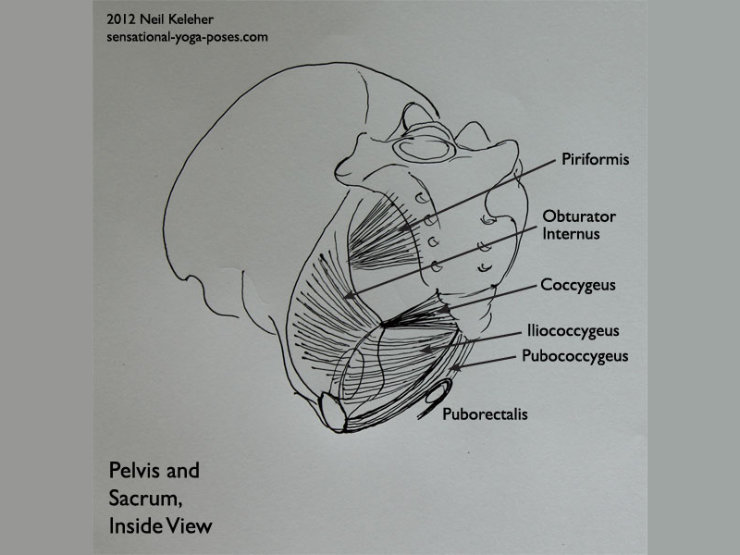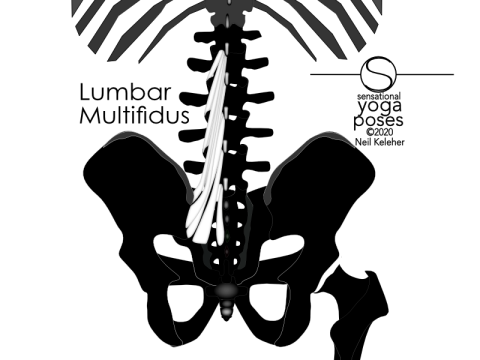Nutation and counter-nutation are two terms used to refer to movements of the sacrum at the sacroiliac joints.
- Nutation is when the sacrum nods forwards relative to the hip bones. Nutation moves the bottom tip of the sacrum, the tailbone, away from the pubic bone.
- Counter nutation is when the sacrum nods backwards. Counter nutation moves the bottom tip of the sacrum towards the pubic bone.
The hip bones move relative to each other and the sacrum to accompany nutation and counter nutation. This results in the pelvis as a whole distorting or changing shape.
This is so that forces are transmitted via the SI joint without overly stressing any single connective tissue structure.
In nutation, as the tail bone (bottom tip of the sacrum) moves away from the pubic bone the sitting bones move outwards. This then widens the bottom of the pelvis.
In counter-nutation the tailbone moves towards the pubic bone and the sitting bones move inwards.
The Sacroiliac Joints and the pubic bone could be thought of as acting like a hinge. When the sitting bones move outwards, the front of the upper crests (ASIC) of the pelvis move inwards. When the sitting bones move inwards, the ASICs move outwards.
- Nutation widens the bottom aperture of the pelvis.
- Counter-nutation makes it narrower.
The pelvic floor muscles (including the PC muscle or pubococcygeus, coccygeus, iliococcygeus., puborectalis, levator prostatae or levator vaginae) can all be used to close, or more accurately, reduce the diameter of the bottom opening of the pelvis. These muscles in combination can be used to draw the tail bone towards the pubic bone, and the sitting bones inwards. At the same time, this causes the top diameter of the pelvis to increase.
The lower fibers of the transverse abdominus (those that attach to the ASIS and the inguinal ligaments) can be used to draw the ASIS inwards. This action causes the tip of the tailbone to move rearwards and the sitting bones to widen. and thus widen the sitting bones. This action can be complimented by an activation of the sacral multifidus which can act to flair the tailbone rearwards (nutating the sacrum).
The pelvic floor muscles can be divided into a left and right half. These muscles fan out from the tailbone towards the front and sides of the pelvis. Because of this, uneven development between left and right sides of the pelvic floor musculature can cause an imbalanced pull on the sacrum.
Because of this, when focusing on activating the pelvic floor muscles, you may want to feel both sides of the pelvic floor musculature. Does the tension feel even on both sides? If not, see if you can make it equal.
For more on Activating the pelvic floor musculature read the:
Mula Bandha
and
pelvic floor muscles
Articles
The spinal erectors and multifidus insert into connective tissue (the thoracolumbar composite of the thoracolumbar fascia) that runs down the back of the sacrum.
When active, the spinal erectors and multifidus may gain enough leverage to pull the tailbone backwards.
The sacral (or "lumbar") multifidus attach to the back of the sacrum but also to the inner facing surfaces of the PSIS (Posterior Superior Iliac Spine). And they attach to the front surface of the Long Posterior Sacroiliac ligament. When tension is added to this ligament it acts to nutate the sacrum (or it acts to resist counter-nutation.) Thus activating the sacral multifidus is very likely to cause (or help cause) nutation of the sacrum.
The gluteus maximus (butt) muscle attaches to connective tissue at the back of the sacrum. It also connects to the pelvis and to the sacrotuberous ligament which connects the sitting bones to the sacrum and upper part of the tailbone.
If you practice squeezing your gluteus maximus (actually I mean "activate") you may find that you can vary the tension. See if you can notice the fibers that are attached to and pull on the sacrum. Is one side pulling on the sacrum more that the other?
For more on activating the gluteus maximus, read up on the hip crease.
And for how it acts with the iliacus and obturators to stabilize the sacroiliac joints with the sacrum nutated, read Interactions of the Gluteus Maximus, SI Joint, Knee Joint and Hip Joint.
Uneven tension in the gluteus maximus from left and right sides may cause uneven stresses on the si joint. The better you are at feeling your butt (and the si joint) the easier it can be to correct any imbalances.
Piriformis attaches to the front of the sacrum. It passed outwards, slightly downwards and slightly forwards, to attach to the top of the thigh bone.
A possible symptom of an chronically active piriformis is tension at the back of the sacrum.
This may be because the piriformis is activating to help to stabilize the hip joint while standing.
One possible way to help the piriformis relax is to activate it's single joint counter part, the quadratus femoris. When the piriformis acts on the si joint and the hip joint, the quadratus femoris only acts on the hip joint.
To help relieve tension at the back of the sacrum try activating quadratus femoris so that piriformis can relax. With legs stable try pulling outwards and downwards on the sitting bones to activate quadratus femoris.
As mentioned, the pelvic floor muscles can be used to pull forwards on the tailbone. One of these muscles, iliococcygeus, attaches to the tailbone but also to the fascia covering the obturator internus.
obturator internus along with gemellus and obturator externus can be used to create space in the hip joint. The amount of space created is small but perceivable, if only as a contraction of muscle around the hip joint.
To balance the external rotation that these muscles also cause, the adductor magnus long head, tensor fascia latae and gluteus minimus may activate to internally rotate the thigh.
Acting in concert these muscles work against each other to maintain the orientation of the thigh while creating space in the hip joint. Disfunction in any of these muscles may result in one thigh being rotate in one direction more than the other. Piriformis or gluteus maximus or even the pelvic floor muscles may be affected and in turn affect the sacral iliac joint.
Learning how to control the muscles of the hip may help, but also stretching both the front and back of the hip joint as well as the inside and outside of the hip joint may help also. When doing hip stretches you may gain extra benefit by not only trying to relax the muscles that you are stretching but also by rhythmically contracting and relaxing them.
Understanding that the SI joint can be affected by imbalances in the hip, imbalance or tightness in the pelvic floor muscles, or even by the erector spinae muscles several courses of action are available.
First of all develop awareness of the sacrum, pelvis, lumbar spine and hip joint. Learn to feel these parts and learn to feel changes in relationship between these parts.
Start with simple exercises like easy breathing or costal breathing to develop awareness of your pelvis, spine and ribcage. Practice Agni Sara to develop transverse abdominis control. Also read the mula bandha article for tips on feeling the pelvic floor muscles.
And read the sacrum article for tips on learning to feel the sacrum moving relative to the pelvis.
(This article on Understanding the psoas may also be helpful.)
In all cases, when learning to feel your body practice doing movements slowly and smoothly. If synchronizing movements with your breath work towards 10 second inhale movements and 10 second exhale movements. If breathing is difficult then focusing on making each part of the movement last 10 seconds.
Once you've developed awareness in these exercises, or after using them as part of a warm up where you tune into your body, use that awareness while performing hip stretches and Psoas Stretches.
Then carry that awareness into doing asymmetrical standing poses and standing on one leg balance poses.
To make one legged balancing poses easier, try using your adductor magnus by pressing your inner thigh back. Or press your inner thigh forwards (which probably activates gracilis.)
And even if you can only do these exercises for short amounts of time a day, say 10 minutes, extend your yoga practice into your every day life by practicing being aware of your pelvis, sacrum and hips while standing or sitting or enjoying a latte.
and the Muscles that Connect it to the Legs, Spine and Pelvis
So we can do movements like the splits...
In Spinal Forward Bends and Spinal Backbends
and Other Seated Yoga Poses
Stabilizing the same side Hip Joint and SI Joint
Hip Rotation Anatomy and Biomechanics for Standing On One Leg
tensioning the long dorsal sacroiliac and sacrotuberous ligament
Feeling and controlling nutation and counter-nutation
Sacrotuberous ligament tensioning, resisting SIJ shear in forward bends
Helping to stabilize the SI joints (for nutation and counter-nutation)
A Tension Control Mechanism for your Abs
Anatomy for Yoga Teachers
SI stability via increased ligament tension
Wifi for Your Spine, Arms and Legs
Published: 2020 08 14
Updated: 2020 11 04




